Table of Contents
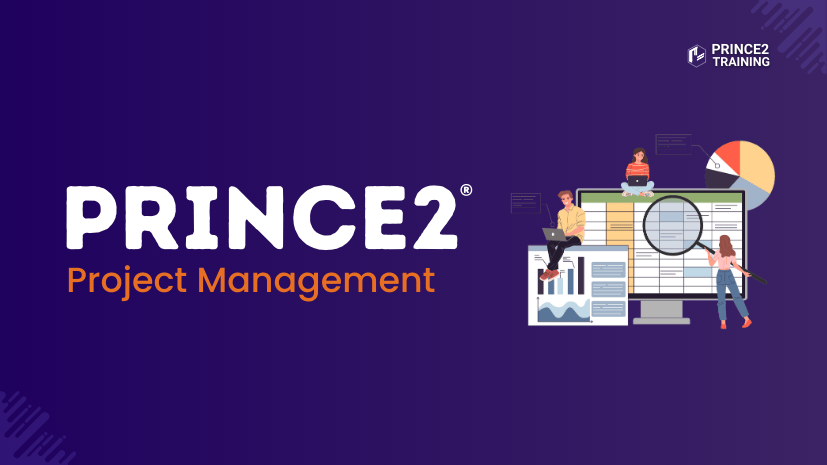
The world of Project Management moves at a dizzying pace, and here structure is the secret to success; PRINCE2 delivers just that. It's one of the world’s most widely adopted Project Management methodologies, trusted for bringing clarity and control to projects of any size. It brings clarity towards team responsibilities, keeps risks under control, and focuses on delivering desired results.
If you want a proper insight into it, we've got you covered. This blog is a comprehensive exploration on What is PRINCE2, including its principles, core themes, benefits, roles and more. So read on and become royalty in harnessing the power of PRINCE2!
Table of Contents
1) What is PRINCE2?
2) What is PRINCE2 Used For?
3) Seven Key Principles of PRINCE2
4) Seven Processes of PRINCE2
5) What are major PRINCE2 Qualifications?
6) Core Themes of PRINCE2
7) Benefits of PRINCE2 Project Management
8) PRINCE2 Project Management Roles
9) Differences Between PRINCE2 and PMP
10) Conclusion
What is PRINCE2?
Projects IN Controlled Environments (PRINCE2) is a popular Project Management method used by people and organisations around the world. It provides a clear structure for managing projects from start to finish. PRINCE2 helps teams stay organised, on track, and within budget.
This method breaks a project into stages, each with its own plan and goals. For example, a team building a new website would use PRINCE2 to plan the design, development, and launch separately. Each stage would be reviewed before moving to the next, ensuring better control and fewer surprises.

History of PRINCE2
Here is how PRINCE2 developed over the years:
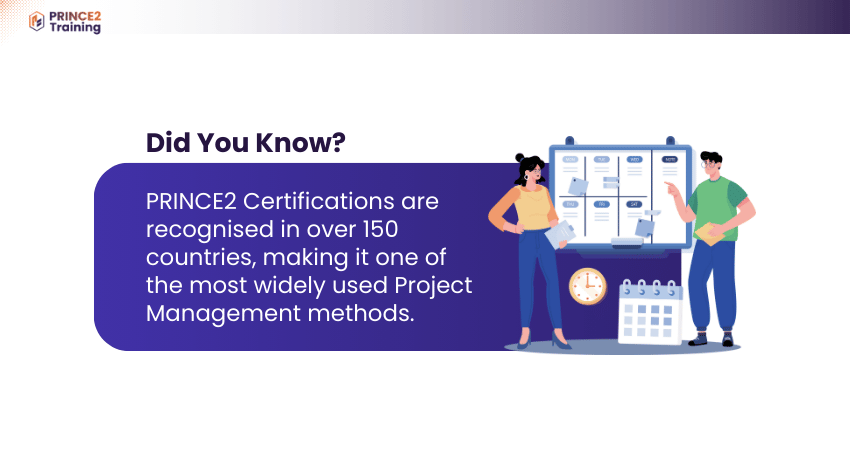
a) Origin: PRINCE2 began in 1989 in the UK, originally used for managing government IT projects.
b) Based on PROMPT: It was built on an earlier project method called PROMPT, created in the 1970s for structured project planning.
c) Expanded Use: In 1996, PRINCE2 was updated to be suitable for all types of projects, not just IT.
d) Global Adoption: Over time, PRINCE2 became popular in many industries around the world due to its flexible and clear structure.
e) Ongoing Updates: It has been improved through updates to match modern project needs, with the latest version managed by PeopleCert.
What is PRINCE2 Used For?
PRINCE2 is utilised to manage projects by providing a clear and systematic project framework. It helps organisations to plan effectively, maintain project control and execute work in an organised way. This ensures every team member understands their roles and why it matters.
This methodology aims to bring justification to a business by ensuring projects that are undertaken deliver real business value. Additionally, it improves management quality and enhances risk management for seamless Project Management. Due to its flexible and scalable nature, it is applicable for any type of project, making it a reliable choice for organisations of any size.
Seven Key Principles of PRINCE2
Here are the seven key principles that guide every PRINCE2 project:
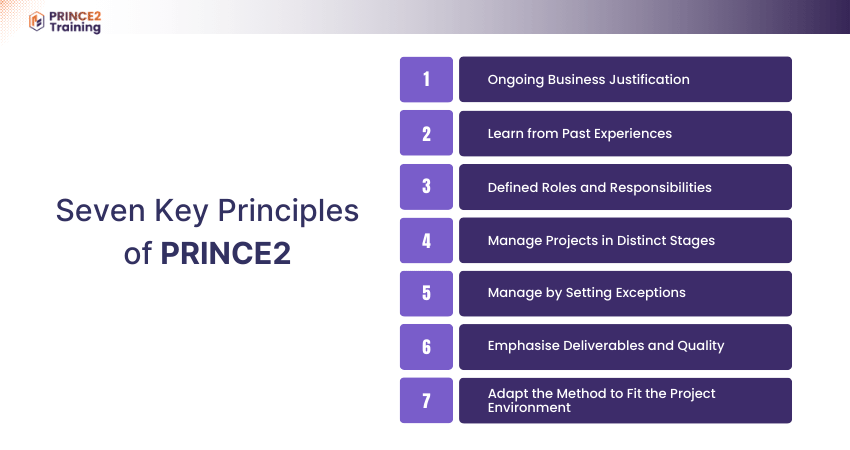
1) Ongoing Business Justification
A project must have a valid reason to start and continue running. If the benefits no longer outweigh the costs or risks, the project should stop. PRINCE2 keeps checking this to make sure the project stays worthwhile.
a) Start only if there’s a clear business reason
b) Check benefits against costs throughout the project
c) Stop the project if the value drops
d) Keep reviewing the goal as things change
2) Learn from Past Experiences
PRINCE2 encourages using lessons from previous projects. Teams should review what went well or wrong before and during the project. This helps avoid repeat mistakes and build on past success.
a) Check past projects for useful lessons
b) Record lessons as the project goes on
c) Use lessons to guide decisions
d) Share lessons at the end of the project
3) Defined Roles and Responsibilities
Everyone involved in a PRINCE2 project must know what they are responsible for. This avoids confusion and keeps tasks organised. Clear roles make it easier to track progress and solve issues.
a) Assign roles clearly from the start
b) Know who approves, manages, or does the work
c) Reduce delays by clarifying duties
d) Keep communication smooth between team members
4) Manage Projects in Distinct Stages
PRINCE2 divides a project into manageable parts or stages. At the end of each stage, progress is reviewed, and plans are updated. This helps stay in control and adjust as needed.
a) Plan one stage at a time
b) Review success before moving forward
c) Adjust plans based on what’s learned
d) Break big projects into smaller steps
5) Manage by Setting Exceptions
PRINCE2 gives people limits within which they can work. If something goes beyond these limits, it must be reported. This approach keeps things under control without constant approvals.
a) Set time, cost, and scope limits
b) Only escalate if something goes off-track
c) Let teams work freely within boundaries
d) Reduce unnecessary meetings and approvals
6) Emphasise Deliverables and Quality
The project should focus on creating high-quality results that meet user needs. Quality standards must be defined early and checked often. This ensures the final outcome is useful and reliable.
a) Define what “good” looks like at the start
b) Check quality throughout the project
c) Avoid rework with early quality checks
d) Deliver what users actually need
7) Adapt the Method to Fit the Project Environment
PRINCE2 is flexible and can be tailored to fit different projects. Not every rule has to apply the same way. The method should match the project size, team, and business.
a) Adjust PRINCE2 to match the project’s size
b) Use only what’s helpful for the situation
c) Stay practical, not overly formal
d) Keep things simple and relevant
Start your PRINCE2® Foundation & Practitioner Training today and boost your Project Management skills
Seven Processes of PRINCE2
PRINCE2 follows seven clear processes that guide a project from beginning to end, helping teams stay in control and deliver good results. Here are these processes:
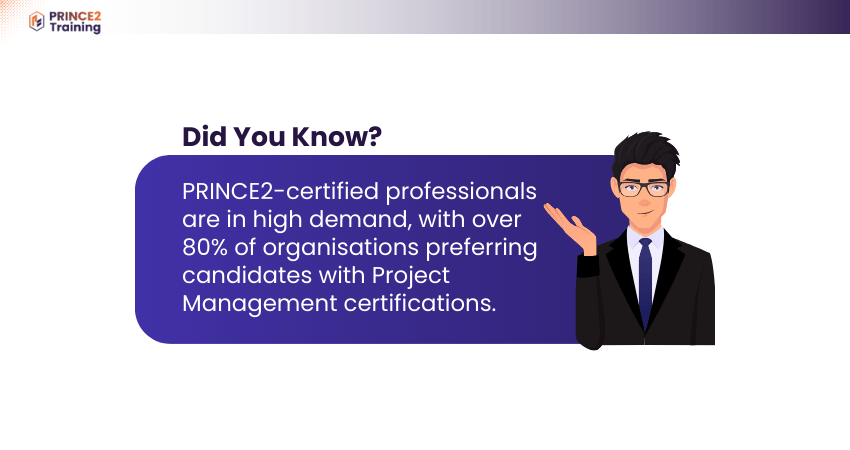
Process 1: Starting up a Project
This is the beginning where the project idea is defined, evaluated, and made clear. It involves appointing the Project Manager, identifying stakeholders, and creating a project brief. The focus is to validate the why for the project and lay down a strong foundation before initiating the planning stages.
Process 2: Initiating a Project
This stage focuses on planning in detail. It focuses on clearly defining the scope, timelines, costs, resources, and controls, such as risk management and communication channels. This helps team members to effectively understand how the project will be delivered, and what the broader vision the project fulfils.
Process 3: Directing a Project
In this step, the project board undertakes responsibility for major decisions and governance. They approve important plans, monitor progress, manage risk strategically and ensure projects are in alignment with the organisational objectives. This lays down a solid groundwork for directing a project.
Process 4: Controlling a Stage
Every stage of a project has essential daily activities that require proper management for a seamless flow. This step refers to the Project Manager’s monitoring of progress, risk management, and ensuring products or services are meeting set standards and customer satisfaction. It helps to keep work on track within the limits of scope, cost, and time.
Process 5: Managing Product Delivery
This stage involves coordinating and completing the project deliverables. Here, work packages are assigned, the project is monitored, and outputs are validated to make sure the project is meeting required specifications. This is thoroughly checked before being handed back to the Project Manager.
Process 6: Managing a Stage Boundary
At the end of every stage, the processes of a project are reviewed for achievements accomplished and performance. This provides insight into the updates required by the project, assessment of risks, and a proposal for the next stage is submitted. It is only when the project board agrees that the next phase can begin.
Process 7: Closing a Project
This is the final process where the project is formally completed. It means deliverables are handed over, success is measured, lessons are recorded, and resources are released. This step ensures proper closure of the project and the maximum value it brought to the organisation and its broader objectives.
PRINCE2 Qualifications
Here are PRINCE2 qualifications that can help you become a skilled Project Manager:
PRINCE2 Foundation
This course teaches the basics of PRINCE2, a structured Project Management method. You will learn the key principles, themes, and processes. It's designed for beginners who want to understand how projects are managed effectively. The course builds a solid foundation for those looking to advance in Project Management. Completing this certification can help you work on projects with confidence.
What you will learn:
a) Basics of PRINCE2 and how it works
b) Roles and responsibilities in Project Management
c) How to organise and control a project
d) Principles for successful project execution
PRINCE2 Practitioner
This course is for those who have completed the PRINCE2 Foundation and want to apply their knowledge to real projects. It focuses on how to tailor PRINCE2 principles to different types of projects. You will learn advanced techniques for planning, executing, and managing projects. It helps professionals take a leadership role in Project Management. Passing this exam demonstrates expertise in applying PRINCE2 effectively.
What you will learn:
a) How to customise PRINCE2 for different projects
b) Techniques for effective Project Management
d) How to manage risks and issues in projects
e) Ways to control project changes and progress
PRINCE2® Foundation and Practitioner Training
This course combines both the Foundation and Practitioner levels into one learning experience. It is ideal for those who want a complete understanding of PRINCE2 quickly. You will start with the basics and progress to advanced applications. It allows professionals to gain both certifications in a shorter time frame. Completing this training can boost career opportunities in Project Management.
What you will learn:
a) Fundamentals and principles of PRINCE2
b) How to apply PRINCE2 to projects
c) Strategies for managing project risks and changes
d) Methods for ensuring project success
PRINCE2 Agile Foundation and Practitioner Training
This course teaches a mix of PRINCE2 and Agile approaches to Project Management. It helps professionals manage projects in a flexible and adaptive way. You will learn how to combine structured Project Management with Agile practices. It is useful for teams working in dynamic and fast-paced environments. Completing this course can enhance skills in managing modern projects.
What you will learn:
a) Differences between PRINCE2 and Agile methods
b) How to blend structure with flexibility in projects
c) Strategies for managing Agile project teams
d) Techniques for fast-paced project delivery
PRINCE2 Agile Foundation Training
This course introduces Agile concepts within the PRINCE2 framework. It is designed for beginners who want to understand how PRINCE2 can work in Agile projects. You will learn basic principles and how to adapt them to fast-changing environments. The course helps professionals who need to manage projects with flexibility. It provides essential knowledge for teams working in Agile setups.
What you will learn:
a) Agile principles and how they fit into PRINCE2
b) How to apply Agile practices in projects
c) Ways to manage changing requirements effectively
d) Techniques for quick project delivery
PRINCE2 Agile Practitioner Training
This advanced course teaches how to apply Agile techniques to PRINCE2 projects. It is for professionals who already understand the basics and want to deepen their skills. You will learn how to balance structure with adaptability in Project Management. It helps teams deliver projects successfully in Agile settings. Completing this course shows expertise in managing Agile projects using PRINCE2 methodology .
What you will learn:
a) How to adjust PRINCE2 for Agile environments
b) Advanced Agile Project Management techniques
c) Ways to handle changing priorities and risks
d) Methods for team collaboration and efficiency
Lead successful projects without second-guessing your process with our PRINCE2 Agile® Foundation and Practitioner Training - Join today!
Core Themes of PRINCE2
PRINCE2 is made up of seven core themes to help navigate every stage of a project. Here is a complete breakdown of each theme that will helpy you understand What is PRINCE2 better.
1) Business Case
This theme ensures the project is justified and continues to deliver real business value. It examines the benefits, costs, and potential risks to confirm if the investment is worthwhile or not. This justification over the project is reviewed for stakeholders to decide whether to continue, stop, or adjust the project.
2) Organisation
It defines the project roles and reporting structure. The primary aim of this theme is to make sure responsibilities are clear by assigning positions, such as the project board, or Team Managers. Implementing strong governance and communication supports effective leadership, engages stakeholders, and improves decision-making.
3) Quality
The theme of quality aims for the project deliverables to meet the agreed standards of quality and stakeholder expectations. This theme involves setting criteria for quality, checking compliance through reviews and testing, and mitigating defects. By prioritising quality, it reduces rework on certain tasks and improves customer satisfaction.
4) Plans
The planning theme explains how and when the project objectives will be accomplished. This theme paves a pathway for the development of different plans by detailing the costs, timeline, deliverables, and resources. It provides a baseline for progress tracking and ensures performances are aligned with agreed business goals.
5) Risk
This theme focuses on spotting, analysing, and managing uncertainties that can affect the project. It involves setting proactive procedures to mitigate threats and leverage opportunities that provide an advantage. By having control over risks in the project lifecycle, this theme keeps projects stable, efficient, and prepared for any challenge.
6) Change
This theme is responsible for managing any changes regarding project scope or deliverables. It introduces processes for logging, evaluating, and approving changes before they are implemented. This is useful for preventing uncontrolled expansion, such as scope creep, and protects the projects time, cost, and quality.
7) Progress
The theme of progress tracks performance and makes sure projects are within the schedule and in compliance. It includes reporting regularly, review of milestones, and monitoring of performance. This enables organisations to detect issues proactively and implement corrective measures.
Benefits of PRINCE2 Project Management
PRINCE2 offers many practical benefits that help projects run smoothly and successfully. Let’s discuss some of the key advantages of PRINCE2 Project Management:
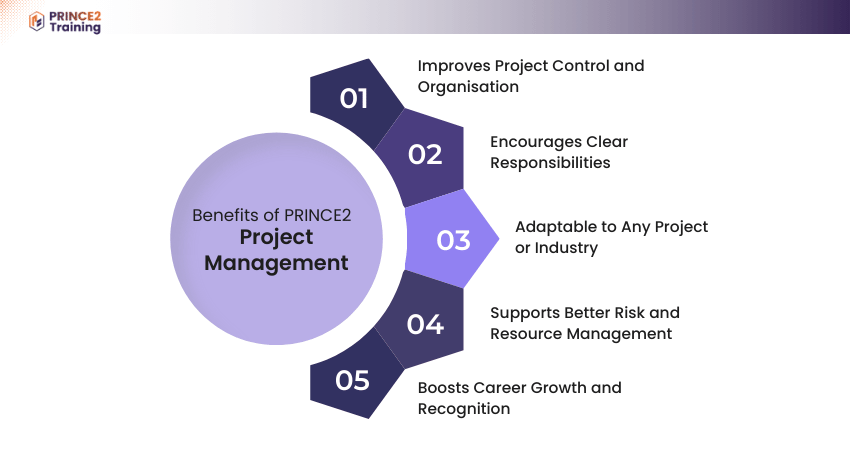
Improves Project Control and Organisation
PRINCE2 gives you a clear plan from start to finish. It helps track progress, control changes, and avoid confusion. Every part of the project is managed in an organised way. This means less stress and more successful outcomes.
a) Clear steps from start to final delivery
b) Tracks progress at every project stage
c) Controls change with an easy-to-follow process
d) Keeps everything organised and on schedule
Encourages Clear Responsibilities
PRINCE2 makes sure everyone knows their role. Each person understands what they need to do and when. This avoids confusion and helps the team work better together. It also improves communication across the project
a) Roles are clearly defined from the beginning
b) Avoids confusion about who does what
c) Team members understand their specific responsibilities
d) Improves communication across all project teams
Adaptable to Any Project or Industry
PRINCE2 works for any size or type of project. You can adjust it based on your team, goals, or industry. It's useful in IT, marketing, construction, and more. This makes it a great fit for different organisations.
a) Flexible structure for all project sizes
b) Works in both public and private sectors
c) Useful in IT, healthcare, and marketing
d) Easy to adjust based on project needs
Supports Better Risk and Resource Management
PRINCE2 helps spot risks early and plan ahead. It also ensures that time, money, and people are used wisely. This reduces waste and improves efficiency. Your project stays safe from surprises.
a) Helps identify and handle project risks
b) Makes better use of team resources
c) Reduces waste of time and money
d) Keeps project prepared for unexpected problems
Boosts Career Growth and Recognition
Knowing PRINCE2 can open new career doors. Employers value this skill across many industries. It shows you can manage projects professionally. PRINCE2 certification also gives you an edge in job interviews.
a) Widely recognised across global job markets
b) Adds strong value to your CV
c) Helps stand out during job interviews
d) Proves strong Project Management knowledge
PRINCE2 Project Management Roles
Here are the key roles associated with PRINCE2 Project Management:
1) Project Manager
a) Leads and controls the project
b) Assigns tasks and ensures work is completed
c) Plans the project and tracks progress
d) Solves problems and keeps things on schedule
2) Senior User
a) Represents the needs of those who will use the project's outcome
b) Ensures the project delivers real benefits
c) Provides input on requirements and expectations
d) Approves key project decisions from a user perspective
3) Supplier
a) Provides the expertise and resources needed for the project
b) Designs, builds, and delivers the final product or solution
c) Ensures technical quality and feasibility
d) Works closely with the project team to meet objectives
4) Project Board
a) Oversees and supports the project at a high level
b) Approves key decisions and solves major issues
c) Ensures the project stays within scope, time, and budget
d) Guides and assists the Project Manager when needed
Turbocharge your Agile Project Management skills with PRINCE2 Agile® Foundation Training – Register today!
Difference Between PRINCE2 and PMP
PRINCE2 and PMP are two of the widely recognised Project Management certifications. Both can significantly impact your career, but they have differences that must be understood to choose the best qualification based on your career goals and industry needs.
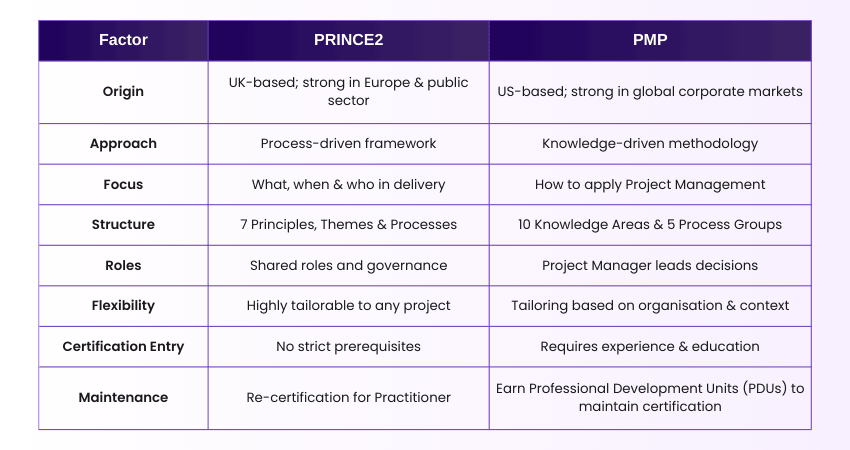
Conclusion
PRINCE2 brings consistency and accountability to project delivery, which is what makes it a trusted framework across industries. Understanding What is PRINCE2, its principles, themes, processes, and defined roles can help teams work smarter and deliver better outcomes. With the right approach, PRINCE2 becomes more than a method; it becomes a reliable guide for managing well-controlled projects from start to finish.
Advance your Project Management career with PRINCE2® Certification Training today!




 Back
Back


 Back to
topics
Back to
topics








